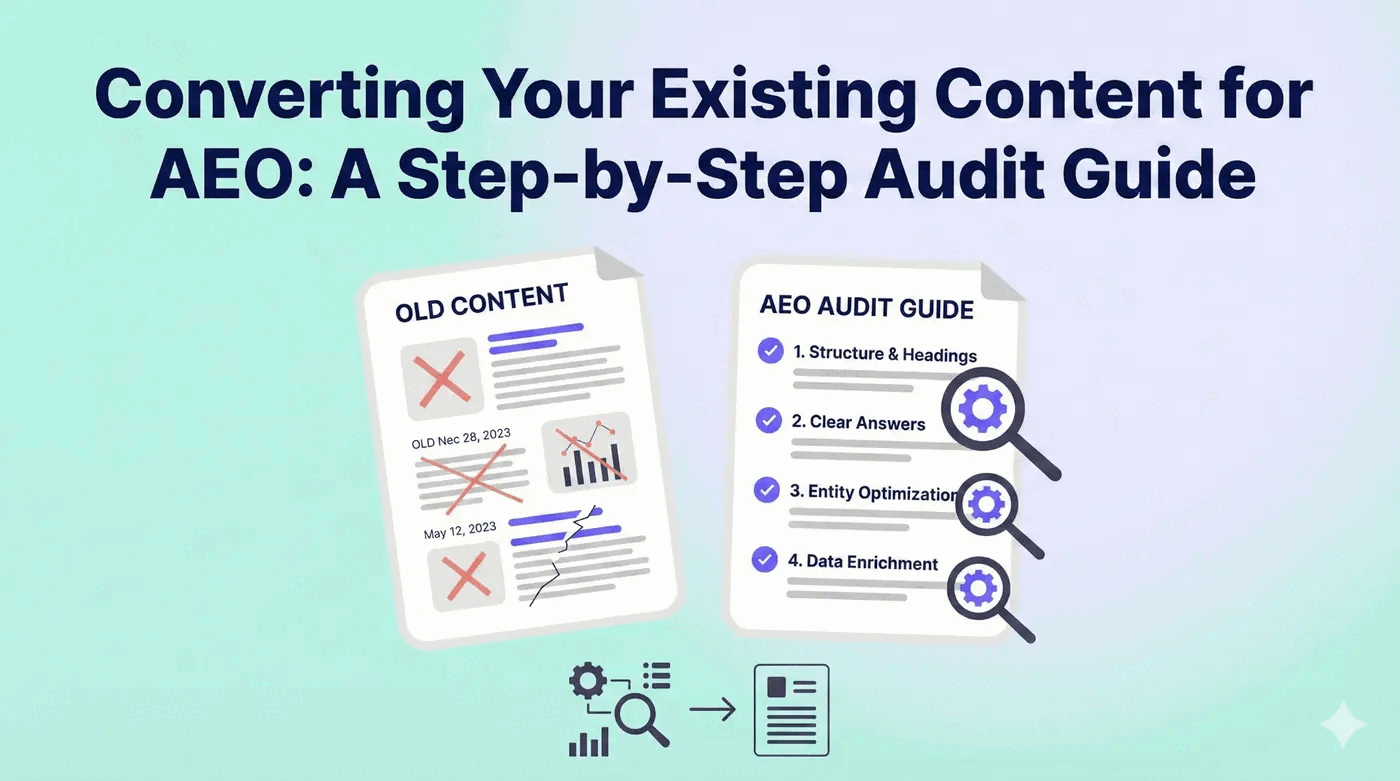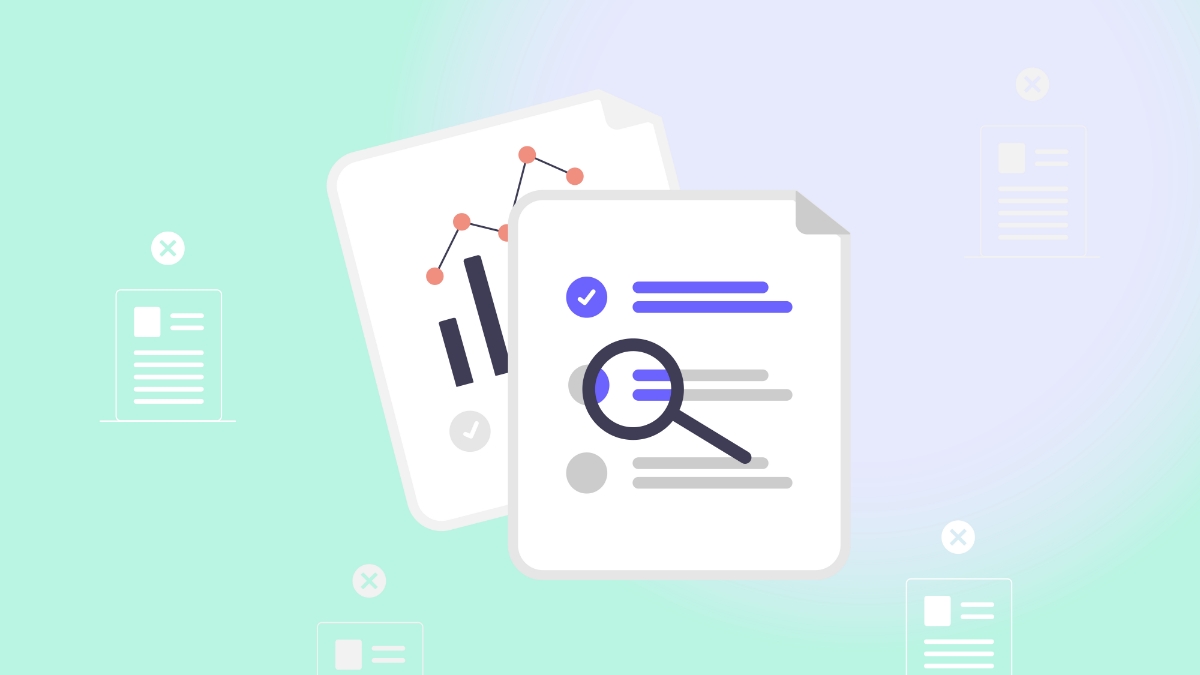This comprehensive guide will walk you through a practical, step-by-step process to evaluate and optimise your current content library. Whether you’re working with years of blog posts, service pages, or technical documentation, this audit framework will help you prioritise your efforts and maximise your AEO impact.
Phase 1: Content Inventory and Classification
Before optimising anything, you need to understand what you’re working with. This phase involves cataloguing your existing content and categorising it by AEO potential.
Step 1: Create Your Content Inventory
Start by building a comprehensive spreadsheet of all your content assets:
- URL/Location: The full web address or file location
- Title: Current page or document title
- Content Type: Blog post, service page, FAQ, case study, etc.
- Word Count: Approximate length of content
- Last Updated: When content was last modified
- Current Traffic: Monthly page views (if available)
Step 2: AEO Readiness Classification
Classify each piece of content into one of four categories based on its current AEO readiness:
| Category | Priority | Characteristics |
|---|---|---|
| AEO Ready | Low | Already answers specific questions, uses conversational language, has proper structure |
| Quick Win | High | Good information but needs formatting, headings, or schema markup |
| Major Revision | Medium | Valuable content but requires significant restructuring or rewriting |
| Archive/Replace | Low | Outdated, irrelevant, or too promotional for AEO purposes |
Phase 2: Question-Answer Mapping Analysis
AEO success depends on how well your content answers specific questions. This phase evaluates how effectively your current content addresses user queries.
Step 3: Identify Implied Questions
For each piece of content, determine what questions it’s attempting to answer, even if not explicitly stated:
- Primary Question: The main query this content addresses
- Secondary Questions: Related queries covered within the content
- Question Format: How, what, why, when, where, who
- Answer Quality: Complete, partial, or unclear
Example Analysis:
Content: “Our Web Development Process”
Primary Question: “How does your web development process work?”
Secondary Questions: “How long does web development take?” / “What’s included in web development?”
Answer Quality: Complete – provides step-by-step process with timelines
Step 4: Conversational Language Assessment
Evaluate how well your content translates to natural, conversational responses that AI systems prefer:
- Uses natural, conversational language rather than corporate jargon
- Provides direct answers early in the content
- Includes clear headings that mirror potential questions
- Explains technical concepts in accessible terms
- Flows logically when read aloud
- Uses active voice predominantly
Phase 3: Technical Structure Evaluation
Technical optimisation helps AI systems understand and extract your content more effectively. This phase examines the structural elements that support AEO.
Step 5: Schema Markup Audit
Check for existing structured data and identify opportunities for AEO-specific schema:
- Current Schema: What structured data already exists
- FAQ Schema Opportunity: Content suitable for FAQ markup
- How-To Schema Potential: Process-based content that could benefit
- Article/Blog Schema: Published content needing proper markup
Step 6: Content Structure Analysis
Evaluate how well your content is organised for AI comprehension:
- Heading Hierarchy: Proper H1, H2, H3 structure
- Information Density: Concise vs. verbose sections
- List Usage: Bullet points and numbered lists for clarity
- Call-out Boxes: Key information highlighted appropriately
Phase 4: Prioritisation and Action Planning
With your audit complete, it’s time to prioritise which content to optimise first and develop an action plan for maximum impact.
Step 7: Content Scoring Matrix
Create a scoring system to prioritise your optimisation efforts. Rate each piece of content on these factors (1-5 scale):
- Current Performance: Traffic, engagement, business value
- AEO Potential: How well-suited for answer extraction
- Optimisation Effort: Time/resources required (reverse score)
- Question Volume: How frequently the topic is queried
Step 8: Quick Win Identification
Identify content that can deliver immediate AEO improvements with minimal effort:
Low-Effort, High-Impact Changes:
- Adding question-based H2 headings to existing content
- Implementing FAQ schema on Q&A style content
- Creating concise summary paragraphs for detailed articles
- Converting process descriptions to numbered how-to formats
Medium-Effort Optimisations:
- Restructuring content to lead with direct answers
- Breaking long articles into question-focused sections
- Adding context and background for technical explanations
Your 30-60-90 Day Implementation Roadmap
First 30 Days: Foundation
- Complete content inventory and classification
- Implement quick wins on your top 10 highest-scoring pages
- Add FAQ schema to existing Q&A content
- Create baseline measurements for monitoring progress
Days 31-60: Strategic Optimisation
- Restructure your next 20 priority pages for question-answer format
- Implement comprehensive schema markup across content types
- Develop new content to fill identified question gaps
Days 61-90: Scale and Refine
- Complete optimisation of remaining high-priority content
- Analyse performance data and refine approach
- Create templates and processes for ongoing AEO content creation
Measuring Your AEO Success
Traditional metrics like page views become less relevant with AEO. Instead, track these indicators:
Primary Metrics:
- Featured Snippet Captures: How often your content appears in AI responses
- Brand Mention Frequency: Citations in AI-generated content
- Voice Search Performance: Rankings for conversational queries
Secondary Metrics:
- Direct Traffic Increases: Users coming directly after AI interactions
- Content Engagement: Time on page, scroll depth for optimised content
- Conversion Quality: Lead quality from AEO-optimised pages
Common Pitfalls to Avoid
- Over-optimising existing high-performing content: If it’s working well for traditional SEO, make minimal changes initially
- Sacrificing depth for brevity: AI systems value comprehensive, authoritative content
- Ignoring user intent: Optimise for the questions people actually ask, not what you want to promote
- Forgetting mobile users: Most AI interactions happen on mobile devices
- Neglecting technical implementation: Schema markup and site structure are crucial for AI understanding
Ready to Transform Your Content Strategy?
Converting your content for AEO is an investment in the future of search. While the process requires systematic effort, the framework provided here will help you approach the task strategically and efficiently.
At Greenhat Services, we’ve helped dozens of businesses successfully audit and optimise their content libraries for Answer Engine Optimisation. Our systematic approach ensures you focus your efforts where they’ll have the greatest impact, maximising your return on investment while positioning your business for the future of search.
Don't have the time or resources to tackle this audit internally?
Our experienced team can conduct a comprehensive AEO content audit for your business, providing detailed recommendations and implementation priorities tailored to your industry and goals.








